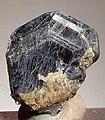Chain silicates
As chain silicates (inosilicates) is referred to silicates , the silicate anions endless chains or belts of corner-sharing SiO 4 - contain tetrahedra. This department of silicates includes important groups of rock-forming minerals such as B. the pyroxene group and the amphibole group .
The linear structure of the silicate chains is reflected in the properties of the chain silicates. The crystals are of low symmetry, mostly triclinic , monoclinic or orthorhombic , but never cubic . Their shape is often prismatic to needle-like stretched in the direction of the silicate chains. The cleavage is usually very good in the direction of the silicate chains.
classification
Silicate classification according to Liebau
In Liebau's structural silicate classification, the chain silicates are silicates with dimensionality 1. The expansion of the silicate anions is unlimited in one direction (1 dimension).
Liebau divides the inosilicates based on the structure of the silicate chains according to the following criteria:
Periodicity:
It indicates after how many silicate chain links (SiO 4 tetrahedron) the structure of the chain repeats itself. The periodicity of natural inosilicates is usually small and is 2 (pyroxene, amphibole) or 3 (e.g. wollastonite). The largest periodicity found so far is 14 (Liebauit).
Unbranched triple single chain of wollastonite
Unbranched four-single chain of the Haradait
Unbranched five-member single chain of rhodonite
Unbranched six-single chain of Stokesite
Unbranched sevens single chains of Pyroxferroit
Unbranched twelve-single chain of Alamosit
Multiplicity:
It indicates how many chains are linked to form ribbons. The multiplicity is usually 1 (e.g. pyroxene) or 2 (e.g. amphibole). In principle, any high multiplicities are conceivable and there is a smooth transition to the layered silicates with increasing chain multiplicity. So z. B. the structurally similar minerals of pyroxenes, amphiboles, chesterite, jimthompsonite and biotite are summarized in the polysomatic series of biopyribols.
Unbranched two-triple chains of jimthompsonite
Mixed unbranched two-double and triple chains in chesterite
Branch:
It indicates whether further SiO 4 tetrahedra branch off from the silicate chain . A distinction is made between open branched silicates and cyclically branched silicates, in which the SiO 4 tetrahedra branching off the chain form closed rings.
Open branched two-fold single chain of astrophyllite
Cyclically branched figure-eight single chain of pellyite
Cyclically branched 14-chain single chain from Liebauit
mixed silicate anions:
Chain silicates can contain chains with different structures or other isolated silicate anions.
Strunz
The 9th edition of Strunz's Mineralogical Tables is based on the silicate classification by F. Liebau and divides the inosilicates division (9.D) primarily according to the periodicity of the chains and then according to the chain multiplicity and branching and finally according to the mineral composition.
- 9.DA chain and ribbon silicates with 2-periodic single chains Si 2 O 6 ; Pyroxene family : unbranched chains with periodicity 2 and multiplicity 1.
- 9.DB chain and ribbon silicates with 2-periodic single chains Si 2 O 6 ; with additional O, OH, H 2 O pyroxene-related minerals
- 9.DC chain and ribbon silicates with branched 2-periodic single chains, Si 2 O 6 + 2SiO 3 → Si 4 O 12 : branched chains with periodicity 2 and multiplicity 1.
- 9.DD chain and ribbon silicates with 2-periodic double chains, Si 4 O 11 ; Amphibole family , orthoamphibole: unbranched chains with periodicity 2 and multiplicity 2.
- 9.DE Klinoamphibole: chain silicates with unbranched chains of periodicity 2 and multiplicity 2.
- 9.DF chain and ribbon silicates with 2-periodic multiple chains: chains with periodicity 2 and multiplicities> 2.
- 9.DG chain and ribbon silicates with 3-periodic single and multiple chains: chains with periodicity 3 and different multiplicity.
- 9.DH chain and ribbon silicates with 4-periodic single chains, Si 4 O 12 : chains with periodicity 4 and multiplicity 1.
- 9.DJ chain and ribbon silicates with 4-periodic double and triple chains: chains with periodicity 4 and multiplicity 2 or 3.
- 9.DK chain and ribbon silicates with 5-periodic single chains, Si 5 O 15 : chains with periodicity 5 and multiplicity 1.
- 9.DL chain and ribbon silicates with 5-periodic double chains, Si 10 O 28 : chains with periodicity 5 and multiplicity 2.
- 9.DM chain and ribbon silicates with 6-periodic single chains, Si 6 O 18 : chains with periodicity 6 and multiplicity 1.
- 9.DN chain and ribbon silicates with 6-periodic double chains: chains with periodicity 6 and multiplicity 2.
- 9.DO chain and band silicates with 7-, 8-, 10-, 12- and 14-periodic chains
- 9.DP transition structures: chain and band silicates - sheet silicates
- 9.DQ Unclassified chain and band silicates
Dana
Dana’s classification, which is widespread in the Anglo-Saxon region , divides the chain silicates first according to their multiplicity and secondly according to the periodicity of the chains.
- 65. Chain silicate minerals (inosilicates)
- 66. Chain silicates: Double unbranched chains, W = 2
- 67. Chain silicates: unbranched chains with W> 2
- 68. Chain silicates: structures with chains of different widths
- 69. Chain silicates: chains with side branches or loops
- 70. Chain silicates: column or tube structures
See also
Individual evidence
- ↑ a b University of Tübingen: Systematics of Minerals - Inosilicates (chain and band silicates)
- ↑ a b c d e f Liebau 1982
Web links
- webmineral: Nickel-Strunz Silicates Classification (Version 10)
- Mineralienatlas : Mineral class 9.D according to Strunz 9th edition - chain and band silicates (inosilicates)
- University of Tübingen: Systematics of the minerals
literature
- F. Liebau (1982): Classification of Silicates in: Reviews in Mineralogy Volume 5: Orthosilicates; Mineralogical Society of America











